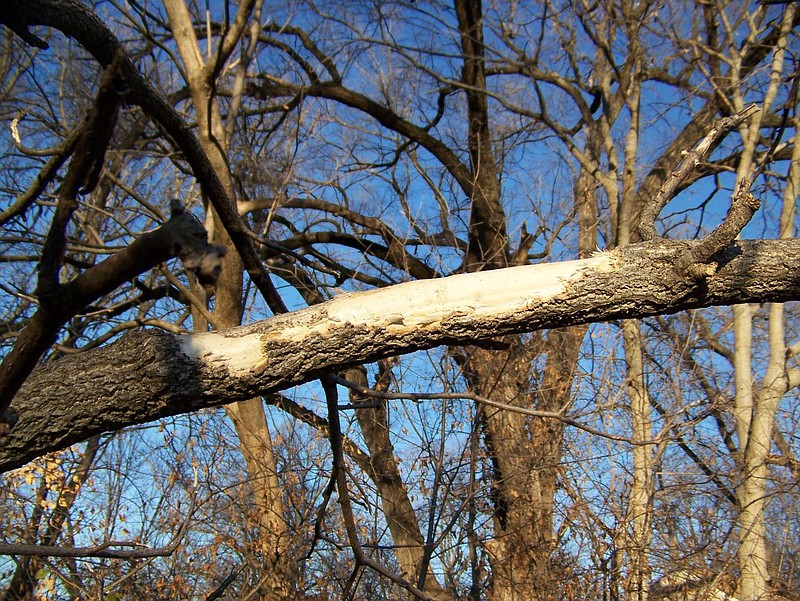Q. I have a modest sized buckeye tree of 20-plus years that is having the bark stripped away on various branches and twigs - but not just a little, a lot, helter skelter all over the tree and way up into the crown (see photo). I can only imagine that this could be done by squirrels. Could you, in your best opinion, advise that it is indeed squirrels? Have you ever gotten reports or similar on squirrels having a penchant for buckeyes? I have all other sorts of trees on my property and never seen anything like this happen. Is there anything that I can do? (submitted by James Quinn to the Plant Information Services at Missouri Botanical Garden, St Louis yes, even I need help sometimes!)
A. I agree - what else could it be? We don't have porcupines in Missouri - thank heavens! Squirrels are notorious bark strippers, as well as twig, bud and bark chewers. You can see a number of other examples on different species in our IPM page. The only other critter this type of damage might be blamed on is bark-rubbing buck deer, but the damage high in the canopy of your tree rules them out in this case. At this time of year, I imagine they could just as likely be chewing for something to eat or else harvesting bark for nest lining? I've never known them to specifically target buckeye bark, but then again, I suspect virtually any species is fair game. Squirrels will be squirrels and it's really hard to figure them out sometimes. Check our garden page on squirrels for ideas on dealing with them.
Q. Where did this crazy Groundhog Day thing come from? Someone told me it came over from Europe.
A. What a good question, and this year's Groundhog Day is even more special, as 02-02-2020 is a palindromic number (the same if written backwards).
It seems there are two similar weather-lores from the British Isles. It's important to understand the origin of these "special days," as the prediction of spring was just an offshoot of these celebrations. From Ireland was a Celtic festival held (about) halfway between winter solstice and spring and now is on Feb. 1. It was called Imbolc, kind of an ancient "feast day" associated with lambing season. The Catholic Church embraced the date, making it St. Brigid's Day. The saying for it is "if a mucky, wet day, winter will soon be over and if it is a brilliant day, buy more fuel and warm underwear."
Candlemas Day (Feb. 2) is a religious holiday celebrated in many places around the world. It marks 40 days after Christmas, the number of days typical after birth for a baby Jewish boy to be presented at the temple in Jerusalem. In Scotland and England the weather proverb is "If Candlemas Day be fair and bright, Winter will have another fight, If Candlemas Day brings cloud and rain, Winter won't come again."
Q. Any recommendations for type of tomatoes to grow this summer? I do not use pesticides or herbicides and need a plant that can withstand our natural pests and problems. Looking for primarily slicing to eat and some sauce prep.
A. There are so, so many tomatoes, I am reluctant to name any. Roma or plum type tomatoes are often used for more making sauces as they are less watery (need to be cooked down less). For more resistance to diseases, F1 hybrid tomatoes feature specific disease resistant traits. In seed catalogs, these should be designated (and some plant tags will also list them). I noticed one seed catalog used this phrase (for a F1 hybrid) "bred for organic systems" and went on to list a large number of diseases for which it was resistant. I encourage you to review two or three different seed catalogs to get a feel for how the information is presented. A great resource serving home gardening interests is the All American Selections, the only national, nonprofit plant trailing organization in North America. Check out their site at all-americaselections.org. Big Beef is a well-known example of a tasty, productive, beefsteak tomato with good disease resistance that was an AAS winner in 1994.

